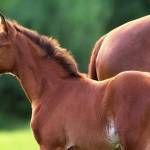No Causative Gene Found for Vitamin E Deficiency Disease in Horses

A neurologic condition called equine neuroaxonal dystrophy/equine degenerative myeloencephalopathy—referred to as eNAD/EDM—occurs in young Quarter Horses. Affected animals must have both a vitamin E deficiency and a genetic predisposition to develop this disease.
Based on previous research, researchers have observed that horses with eNAD/EDM have abnormalities in vitamin E metabolism. Specifically, the gene coding a protein called CYP4F2, a major metabolizer of vitamin E, has increased expression in horses with eNAD/EDM compared with healthy horses. Further, research in humans with a similar disease has identified other “mutations,” specifically polymorphisms, in various genes responsible for vitamin E uptake, transport, and metabolism.
Based on these findings, the genomes of horses with and without eNAD/EDM were scanned with an eye toward finding polymorphisms in various genes involved in vitamin E metabolism.
“No genetic variants were found for the CYP4F2 gene, suggesting that this gene does not play a role in eNAD/EDM,” said Catherine Whitehouse, M.S., a nutrition advisor for Kentucky Equine Research.
Instead, two mutations in the gene called cluster determinant 36 (CD36) were significantly associated with eNAD/EDM; however, many horses diagnosed with the disease on postmortem examination did not have either mutation. This means that the CD36 mutations could have been false positives or there is genetic heterogeneity for eNAD/EDM in Quarter Horses (i.e., that gene is not responsible for the disease in all horses).
“This disease is an inherited condition seen in young Quarter Horses with a vitamin E deficiency occurring early in life. Therefore, the best way to prevent eNAD/EDM is to supplement pregnant mares with high doses of water-soluble RRR-alpha-tocopherol during the last trimester of gestation and the resulting foal through the first two years of life,” said Whitehouse.
Prevention is of utmost importance because the only way to definitively diagnose the condition is on a postmortem examination, and there is no effective treatment once eNAD/EDM develops.
“Kentucky Equine Research offers a highly bioavailable, natural-source vitamin E supplement, Nano-E. This is a research-proven, water-soluble product that optimizes vitamin E absorption in the small intestine,” described Whitehouse.
In addition to pregnant Quarter Horse mares and foals at risk for eNAD/EDM, many other horses benefit from this water-soluble vitamin E supplement, including breeding and performance horses.
*Ma, Y., S. Peng, C.G. Donnelly, S. Ghosh, A.D. Miller, K. Woolard, and C.J. Finno. 2024. Genetic polymorphisms in vitamin E transport genes as determinants for risk of equine neuroaxonal dystrophy. Journal of Veterinary Internal Medicine 38(1):417-423.








